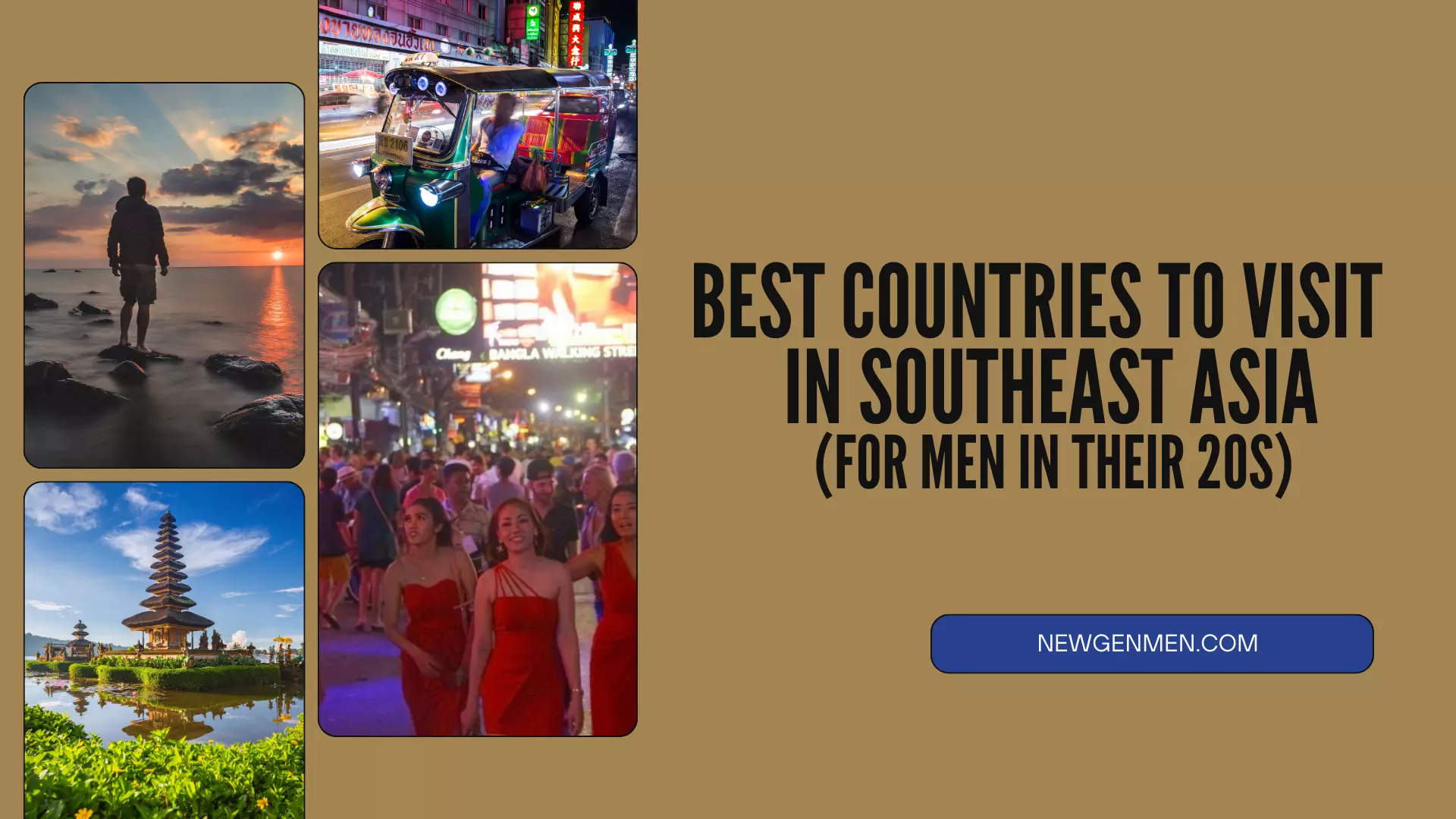See the 10 best countries to visit in Southeast Asia for men in their 20s to embark on the trip of a lifetime
Southeast Asia is the ideal playground for 20-something globetrotters. Known for its breathtaking landscapes, amazingly cheap food, diverse culture, and vibrant street and nightlife scenes, this region promises to satisfy your wanderlust, no matter what you’re looking to get into.
We’ll go through the 10 best countries to visit in Southeast Asia for men in their 20s to embark on the trip of a lifetime, before it’s time to completely grow up and take on adult responsibilities.
10 Best Countries To Visit In Southeast Asia For Men (20-Somethings)
1. Bali, Indonesia

Expensiveness: 3/5
Why Go: Bali is a tropical paradise known for its dramatic landscapes, rich culture, and vibrant nightlife. Whether you’re into surfing, yoga, or exploring traditional Balinese temples, Bali has it all. The rice terraces in Tegallalang and the volcanic Mount Batur are iconic attractions, perfect for trekking and sunrise viewing. Bali’s nightlife is legendary, especially in Kuta and Seminyak, with beach parties and vibrant clubs like Sky Garden.
What To Eat: For dining, don’t miss Warungs (local food markets) for Nasi Goreng (fried rice) and Lawar (spiced coconut and vegetable salad). Being an island, Bali offers an abundance of fresh seafood. You can enjoy grilled fish, prawns, crab, and other seafood dishes at beachfront restaurants.
How to Get Around: Rent a scooter to explore the island at your own pace or hire a driver for day trips. Blue Bird Taxis are a reliable choice. Public transportation is limited, so getting a local SIM card for ride-sharing apps can be a lifesaver.
2. Bangkok, Thailand
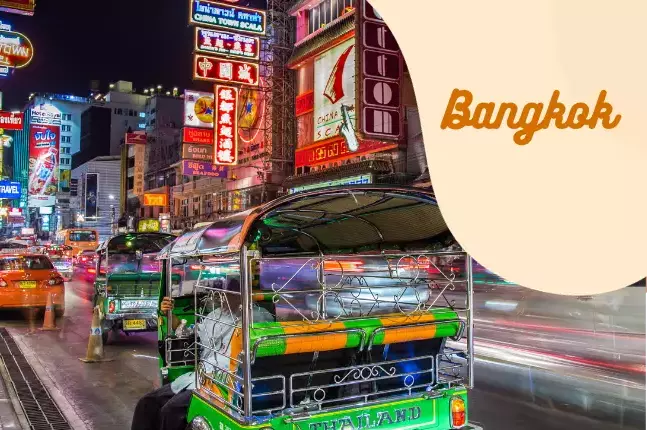
Expensiveness: 2/5
Why Go: Bangkok is a city that never sleeps, with a culture deeply rooted in tradition and modernity. Dive into the rich Thai culture by visiting Wat Pho, home to the iconic reclining Buddha, and Wat Phra Kaew, the Temple of the Emerald Buddha. Visit the iconic Grand Palace and explore the vibrant Chatuchak Weekend Market. Nightlife in Khao San Road is a backpacker’s dream, with countless bars, street food vendors, and a bustling adult-fun industry.
What To Eat: Dining in Bangkok is a culinary adventure, with dishes like pad thai, green curry, red curry, tom yum soup, som tam (papaya salad), and massaman curry. It’s also known for its vibrant street food culture. You’ll find street vendors and night markets selling a wide range of dishes, from satay and skewers to noodles, grilled seafood, and sweet treats like mango sticky rice.
How to Get Around: The Skytrain and the Metro are convenient ways to move around the city. Tuk-tuks and taxis are readily available, but always ensure the meter is used in taxis. Motorcycle taxis are a speedy way to navigate through traffic.
3. Ho Chi Minh City, Vietnam
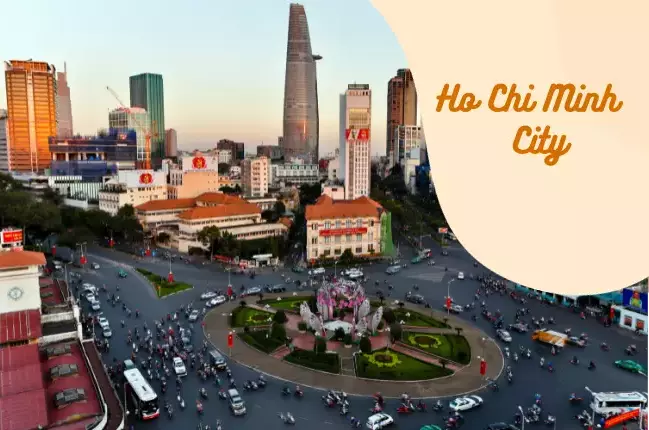
Expensiveness: 1/5
Why Go: Formerly known as Saigon, this city is a historical and cultural treasure trove. Visit the War Remnants Museum, the Cu Chi Tunnels, and the Notre-Dame Cathedral Basilica of Saigon. Take a leisurely stroll along the Saigon River while you sample delicious Vietnamese street food at Ben Thanh Market. Rooftop bars with panoramic views and packed night clubs like Lush Saigon, Blanchy’s Tash, and The Observatory are popular weekend hot spots.
What To Eat: Dining is cheap, fast, and delicious with country staples like pho, banh mi, and goi cuon (spring rolls) available on every corner. At night, venture to the lively Bui Vien Street for bars and street food where you can just pull up a seat and enjoy a quick snack.
How to Get Around: Use the city’s extensive network of buses and the Saigon River for boat transport. Taxis and ride-sharing services are affordable and convenient options for short trips.
4. Phuket, Thailand
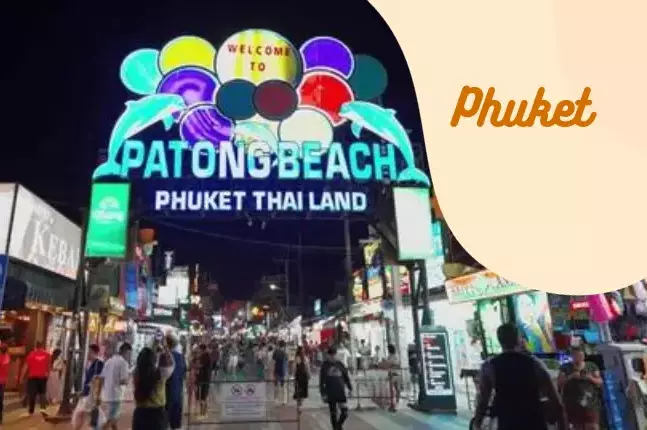
Expensiveness: 3/5
Why Go: Phuket is Thailand’s tropical playground, offering a mix of adventure and relaxation. Explore the Old Phuket Town with its colorful Sino-Portuguese architecture and visit Big Buddha for epic views to take your selfies. Patong Beach, located on the west coast of Phuket, is the island’s nightlife epicenter. The area is packed with bars, nightclubs, go-go bars, and restaurants. You’ll find everything from beachfront bars to late-night clubs with a variety of music genres.
What To Eat: Phuket’s dining options range from fresh seafood at beachside restaurants to delicious local dishes like Tom Yum Goong, pad thai, and green curry. The night markets and street food stalls offer a variety of delicious and affordable snacks and dishes. Phuket also offers upscale dining experiences, with many high-end restaurants featuring gourmet cuisine, often with breathtaking sea views.
How to Get Around: Rent a scooter or take tuk-tuks for shorter distances. Taxis are available, but negotiate fares in advance or make sure your driver turns on the meter.
5. Siem Reap, Cambodia
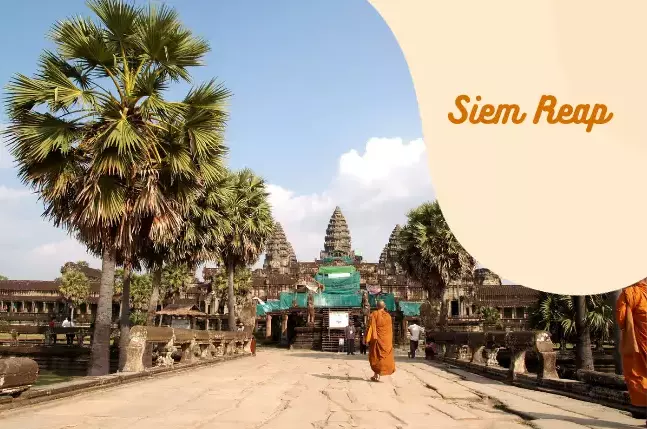
Expensiveness: 1/5
Why Go: Siem Reap is your gateway to the awe-inspiring Angkor Wat temple complex and is a UNESCO World Heritage Site. Explore the vast temples, including Ta Prohm, famously featured in “Tomb Raider.” Discover the ancient city of Angkor Thom and visit the Landmine Museum and Relief Center. If you’re looking for more of a nightlife scene, head over to Phnom Penh for cultural shows as well as modern clubs and bars.
What To Eat: Cambodia is known for its budget-friendly dining options. Local markets, food stalls, and Khmer-style restaurants offer economical choices for travelers. Cambodian cuisine offers an array of flavors, from Fish Amok to Lok Lak. Visit Pub Street for a lively nightlife experience and to try exotic insect snacks.
How to Get Around: Rent a bicycle to explore the temple complexes, hire a tuk-tuk for more distant sites, and use remork-moto (motorcycle taxis) for short trips.
6. Luang Prabang, Laos
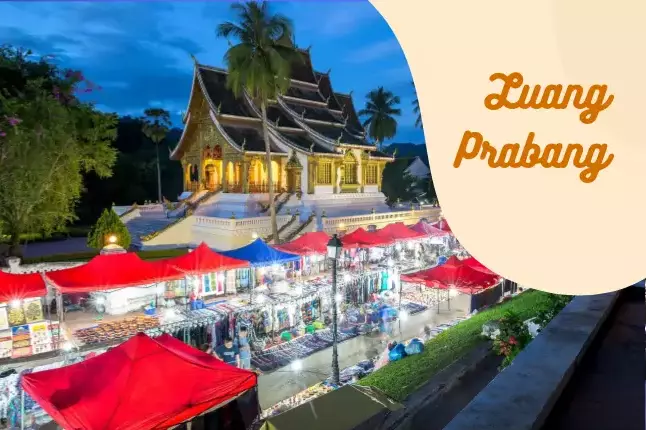
Expensiveness: 1/5
Why Go:
Luang Prabang is a tranquil town along the Mekong River. Add some zen into your life by visiting Wat Xieng Thong and experiencing the daily alms-giving ceremony. Explore the stunning Kuang Si Falls, ideal for beach lounging and a refreshing swim. Luang Praband and most of Lao’s nightlife has more of a relaxed vibe with laid back bars and small dance clubs playing both local and popular international music.
What To Eat: Lao cuisine is a highlight for tourists in Luang Prabang. You can savor traditional dishes like laap (a minced meat salad with herbs and spices), tam mak hoong (spicy green papaya salad), and mok pa (fish steamed in banana leaves). There is a vibrant street food scene, especially in the morning when the morning market comes alive with food vendors. You can try local dishes such as khao soi (a noodle soup) and grilled meat skewers.
How to Get Around: Walk or rent a bicycle for exploring the town. Tuk-tuks and jumbos (open-air shared taxis) are available for nearby attractions.
7. Kuala Lumpur, Malaysia
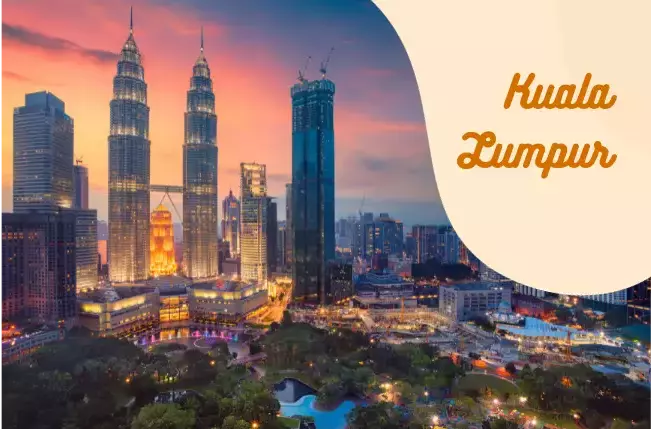
Expensiveness: 2/5
Why Go:
Kuala Lumpur, Malaysia’s capital, is a city of contrasts. The iconic Petronas Twin Towers and Menara KL Tower provide breathtaking city views. Batu Caves is a unique Hindu temple complex built inside limestone caves. Explore the bustling Petaling Street in Chinatown and the Bukit Bintang shopping and entertainment district. Bukit Bintang is packed with bars, restaurants, and clubs, making it a popular choice for a night out. Popular clubs include Zouk, KL Live, and Marini’s on 57, known for its rooftop dance floor and breathtaking city views.
What To Eat: The dining scene for tourists in Kuala Lumpur, Malaysia, is diverse and caters to a wide range of tastes and budgets. Dive into culinary adventures with diverse Malaysian cuisine, from popular dishes like nasi lemak, rendang, and satay. Places like Jalan Alor and Petaling Street offer a plethora of street food options, making it a great destination for foodies. You can sample a diverse array of dishes in a lively atmosphere.
How to Get Around: The city’s public transportation includes the LRT, MRT, and monorail. Taxis and ride-sharing apps are convenient for getting around the city.
8. Boracay, Philippines
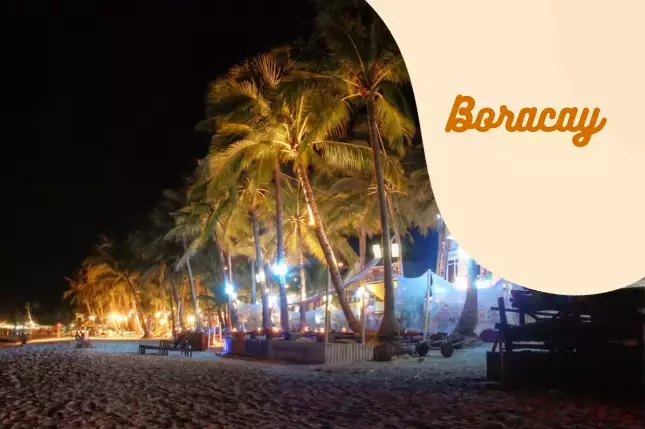
Expensiveness: 2/5
Why Go: Boracay is a Philippine gem famous for its soft, white sand beaches and water sports. Enjoy kiteboarding, scuba diving, and island hopping. In the evenings, head to White Beach for vibrant nightlife. Many beachfront bars and lounges offer happy hour specials and beachfront seating, allowing you to enjoy cocktails and tropical drinks while taking in the beautiful sunset. Locals are friendly and love meeting foreigners.
What To Eat: Boracay offers tourists the chance to savor authentic Filipino dishes. You can try local specialties like adobo (marinated and stewed meat), sinigang (sour soup), and lechon (roast pig). Seafood is also a highlight, with fresh catches of fish, shrimp, and crab. Many restaurants and cafes in Boracay are located on or near the beach. Dining with your feet in the sand and a view of the turquoise waters will have you feeling like a king.
How to Get Around: Electric tricycles and pedicabs are the main modes of transportation on the island. Shuttle trams can also be found to travel to nearby beaches at a low, group cost.
9. Yangon, Myanmar
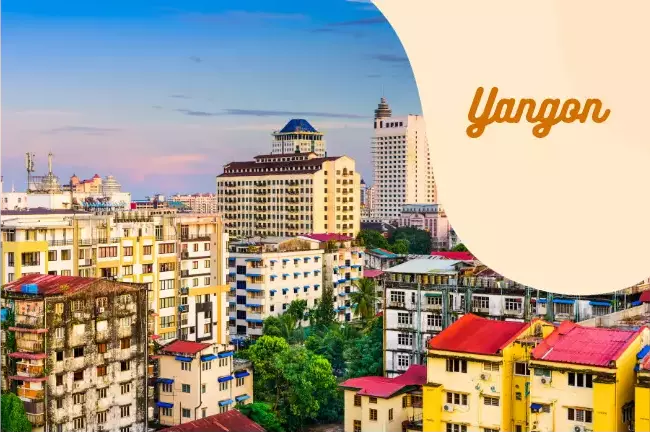
Expensiveness: 1/5
Why Go:
Yangon is Myanmar’s largest city, offering a blend of tradition and modernity. Visit the stunning Shwedagon Pagoda, a symbol of Buddhism. Explore the historic Bogyoke Aung San Market for souvenirs. The nightlife hub of 19th Street in Chinatown consists of smaller clubs, live music venues, and bars that are more calm in ambiance but still a great time to mingle with locals.
What To Eat: Yangon is an excellent place to explore Burmese cuisine. Try local dishes like mohinga (noodle soup), Shan-style noodles, tea leaf salad, and various curries. Yangon also has a thriving street food scene, especially in Chinatown and around Sule Pagoda. Street vendors offer a wide variety of dishes, including grilled skewers, noodles, and fried treats.
How to Get Around: Use local buses or rent a taxi for getting around the city. Walking is an option for shorter distances.
10. Hanoi, Vietnam
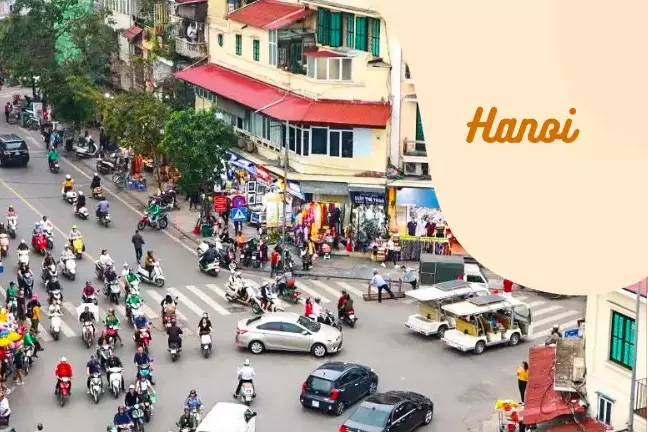
Expensiveness: 1/5
Why Go:
Hanoi, Vietnam’s capital, is a charming blend of old-world traditions and modern life. Explore the historic Old Quarter with narrow streets and street vendors. The Hoan Kiem Lake area is perfect for leisurely strolls. While it might not have the same party reputation as cities like Bangkok or Ho Chi Minh City, Hanoi has its own charm. Hanoi’s Old Quarter is a hub for nightlife, with narrow streets filled with bars, pubs, clubs, and restaurants. It’s a great place for bar hopping and experiencing the local atmosphere.
What To Eat: Hanoi is the go-to place to experience traditional Vietnamese dishes. Must-try local specialties include pho (noodle soup with beef or chicken), bun cha (grilled pork with noodles), banh mi (Vietnamese sandwich), goi cuon (fresh spring rolls), and ca phe trung (egg coffee). Visit local markets, street stalls, and small local eateries to savor authentic flavors.
How to Get Around: Walk around the Old Quarter and Hoan Kiem Lake area. Use cyclos (cycle rickshaws) for a unique city tour. Taxis and ride-sharing services are readily available.
How Long is a Travel Visa to Southeast Asia

Visa duration and requirements may vary based on your nationality and the purpose of your visit. Here are approximate visa time frames for some Southeast Asian countries:
- Brunei: Tourist visas are typically issued for 30 days.
- Cambodia: Tourist visas are usually issued for 30 days. Extensions for an additional 30 days are often possible.
- Indonesia: Tourist visas are typically issued for 30 days, with the possibility of extending for another 30 days.
- Laos: Tourist visas are typically issued for 30 days, with extensions for another 60 days possible.
- Malaysia: Tourist visas are often issued for 30 to 90 days, depending on your nationality.
- Myanmar (Burma): Tourist visas are usually issued for 28 days.
- Philippines: Tourist visas are often issued for 30 days, and you can extend them for an additional 29 days.
- Singapore: Tourist visas are typically issued for 30 days, with the possibility of extending for another 90 days.
- Thailand: Tourist visas are commonly issued for 30 days. Extensions for an additional 30 days are possible.
- Vietnam: Tourist visas are often issued for 30 days, and you may be able to extend them for another 30 days.
Multiple-entry visas: If you plan to visit multiple countries in the region, you might obtain a multiple-entry visa that allows you to enter and exit the countries within a specific period. The duration can vary.
Keep in mind that visa policies are subject to change, and some countries may offer various types of visas with different durations, depending on the purpose of your visit (e.g., tourist, business, education). Make sure to consult the official website of the embassy or consulate of the country you intend to visit, or contact the relevant authorities to get the most up-to-date information regarding visa durations, application procedures, and fees.
Additionally, your nationality may affect the visa requirements, so be sure to check if you’re eligible for visa-free entry or visa-on-arrival in certain countries.
Read More:

